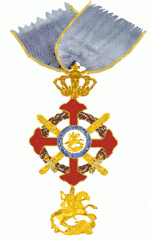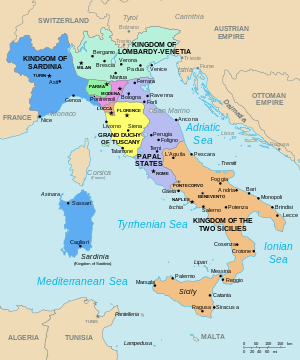Order of Saint George of the Reunion
The Order of Saint George of the Reunion is an order of knighthood of the Kingdom of the Two Sicilies. It was established to replace the Royal Order of the Two-Sicilies.[1]
| Order of Saint George of the Reunion | |
|---|---|
 Original badge of the order, 1819 | |
| Awarded by the Kingdom of Two Sicilies | |
| Type | Dynastic order |
| Established | 1 January 1819 |
| Awarded for | Military valor and merit |
| Founder | Ferdinand I of the Two Sicilies |
| Precedence | |
| Next (higher) | Royal Order of the Two-Sicilies |
| Next (lower) | Royal Order of Francis I |
Ribbon of the order | |
It was created on 1 January 1819 by Ferdinand I of the Two Sicilies to reward military valor and merit. It received its name to celebrate the reunification of the dominions located namely (Naples and Sicily) into one kingdom after the Congress of Vienna.
The dynastic dispute within the House of Bourbon-Two Sicilies means the position of Grand Master is disputed between Prince Pedro, Duke of Calabria and Prince Carlo, Duke of Castro. The head of the Spanish branch, Prince Pedro, considers this Order to be dormant and it is no longer awarded.
Grades
The Order is divided into eight Ranks:
- Knights of Grand Cross with neck ribbon, cross and plate;
- Grand Officers, with neck ribbon, cross without St. George and plate with smaller sunburst decoration;
- Commanders with neck ribbon and cross;
- Officers, with ribbon, small tassel and cross at buttons;
- Knights of Law, with ribbon and cross and buttons;
- Knights of Mercy, with ribbon and cross at buttons;
- Golden medal;
- Silver medal.
 | ||
Insignia
The decoration is formed by: ruby enameled lilied cross with in the middle a white enameled round plate bearing the image of a mounted St. George running the dragon through with his sword, bordered by a circle of blue enamel with the inscription "IN HOC SIGNO VINCES" and a laurel wreath.
The decoration of the Knights of Grand Cross has a golden image of St. George hanging down from the lower arm of the cross; the Royal Crown tops it.
See also
References
- Collezione delle leggi e de' decreti reali del regno delle Due Sicilie (in Italian). Stamperia reale. 1819. p. 13.
External links
| Wikimedia Commons has media related to Order of Saint George and Reunion. |
- Del real ordine militare di S. Giorgio della riunione: Legge istitutiva ... e decreto che abolisce l'ordine delle Due Sicilie, 1853. (in Italian)
